Babri demolition: How HC verdict discredited 'eminent' historians
https://www.firstpost.com/india/babri-demolition-how-hc-verdict-discredited-eminent-historians-547549.html By R Vaidyanathan Dec 06, 2012
It runs to more than 8,000 pages and it contains is a marvelous set of documents on the Ram Janmabhoomi-Babri case. On the 20th anniversary of the demolition, it is worth looking at some aspects of the judgment delivered by the full bench of the Allahabad High Court in September 2012.
The judgment, which awarded two parts of the disputed land to Hindu groups and one to the Muslim one, is now being contested by the parties in the Supreme Court, but it offers an extraordinary insight in to our culture, history, and civilisational ethos. It dwells at length on Persian sources, German writings, French observations, Urdu literature and, of course, Sanskrit evidence. It deals with archeology, history, linguistics, anthropology, zoology, literature, the puranas, the jataka tales and many other subjects and disciplines.
The sweep of the judgment and the canvas covered is mind-boggling and it makes one proud of our judiciary. This judgment will be quoted discussed and dissected by legal as well as academic experts for several decades.
But we shall not discuss the judgment’s core aspects, and focus instead on what it has to say on our “eminent historians” who were shown to be not so eminent, and their attitudes fairly unacademic.
Many “independent experts”, historians and archeologists appeared on behalf of the Sunni Waqf Board but in the end the special bench of three judges unanimously dismissed the objections raised by them about the ruins of a temple under the demolished structure. It was Justice Sudhir Agarwal who put their claims to judicial scrutiny.
Interestingly many of these “experts” had deposed twice in the court — once before the ASI excavations and another after. Before the excavations they asserted that there was no temple beneath the disputed structure and after it was dug up they began to claim that what was unearthed was a mosque or stupa. Not only that, they found themselves withering under judicial scrutiny in spite of writing signed articles and issuing pamphlets and long public letters.
The judge asked pointed queries which might never been asked by their students.
The cross-examination covers several pages and a gripping reading. It shows the levels to which our academics have fallen and become hand maidens of the political machinery. Let us look at some of their statements, and how they do nothing to enhance their profession’s reputation.

Activists of the Bajrang Dal Party hold torches while standing behind a model of Ram Temple on the 14th anniversary of the demolition of the Babri Masjid. AFP
Supriya Verma an, “expert” who challenged the excavations done by the ASI, had not read the radar survey report on ground penetration that led to the court order for excavation. Verma and Jaya Menon, another “expert,” were not present at the time of actual excavations but alleged that pillar bases at the excavated sites were planted.
Suvira Jaiswal says: “Whatever knowledge I gained with respect to the disputed site is based on newspaper reports or what others told.” She also confessed that she “prepared a report on the Babri dispute after reading newspaper reports and on the basis of discussion with my medieval history expert in my department”.
Jaiswal made an important clarification: “I am not giving (my) statement on oath regarding Babri Mosque without any probe and not on the basis of my knowledge; rather I am giving the statement on the basis of my opinion.”
When opinion can be history why are they all screaming that "faith" cannot be an equally relevant criterion?
Archaeologist Shereen Ratnagar admitted she did not have any “field” experience as far as Babri was concerned and had written an “introduction” to the book of another “expert” who deposed before the court, namely Prof D Mandal. This expert witness for the Waqf Board admitted he wrote his “Ayodhya: Archaeology after Demolition” without even visiting Ayodhya and with an eye to the presidential reference to the Supreme Court. Mandal also admitted that “Whatsoever little knowledge I have of Babur is only that Babur was (a) ruler of the 16th century. Except for this I do not have any knowledge of Babur.” The judge, Agarwal, was sufficiently moved to say about Mandal that “the statements made by him in cross-examination show the shallowness of his knowledge on the subject”.
Suraj Bhan was providing evidence based on medieval history but another expert of Muslim parties, namely Shireen Musavi, says that Bhan is an archeologists and not a historian.
The ASI report submitted to the court after an excavation of the site had brushed aside the so-called Historians’ Report to the Nation authored by RS Sharma, M Athar Ali, DN Jha and Suraj Bhan, released in May 1991. This document was a plea to the government of India “to include impartial historians in the process of forming judgment on historical facts”. As an example of this “impartial” history, it was argued that “the full blown legend of the destruction of a temple at the site of Rama’s birth and Sita ki Rasoi is as late as the 1850s. Since then what we get is merely the progressive reconstruction of imagined history based on faith.” But Bhan confessed that the grandly titled Historians’ Report to the Nation was written under “pressure” in six weeks and “without going through the record of the excavation by BB Lal”.
Shireen Musavi suggested that “the legend of Ayodhya being the birthplace of Rama is found from the 17th century, prior to which there is no legend about Rama’s birthplace in medieval history”. However, during cross-examination, Musavi admitted: “It is correct that in Sikh literature there is a tradition that Guru Nanak had visited Ayodhya, had darshan of Ram Janmasthan and had bathed in the River Saryu.”
Prof Mandal retired from the Department of Ancient History and Archaeology, Allahabad University. He was appointed on an ad hoc basis as Lecturer in 1972 but prior to that he claimed to have worked as exploration assistant since 1960. Initially he appeared as an expert to depose that there was no archaeological evidence to show either the existence of any temple at the disputed site or that a temple was demolished before construction of the disputed structure. The statements made by him in cross-examination show the shallowness of his knowledge and provide a sample about all these “eminences”
A few of his quotes: “I never visited Ayodhya”. “I do not have any specific knowledge of the history of Babur's reign.” “Whatsoever little knowledge I have about Babur is only that Babur was the ruler of the 16th century. Except for this I do not have any knowledge of Babur. I do not have knowledge of anything in 2nd Para of the editorial preface to my book (exhibit 63) in which Romila Thapar has written that Vishwa Hindu Parishad, BJP and Rashtriya Swayamsevak Sangh, for the first time, raised the issue of the Babri Masjid being located on the place which was earlier Rama's birth place. I also do not know whether or not it is correctly written on page 10 of the aforesaid preface that Ayodhya is a site of pilgrimage for adherents of Ramanand school.” “The Communist Party issues a red card, and I am its holder. It is true that I have no faith in religion.”
Further: “It is true that I have not seen the disputed building as yet. I did not make any physical investigation of stone used in inscriptions carved out in the disputed building. Likewise, I also did not make physical investigation of basalt stone.” “My finding in my book (exhibit 63) is not based on any article. My finding is based on materials written in this connection and given in the book (paper no.118C-1/35) filed in Suit No.5/89 and chiefly on the photograph (paper no118C-1/36) depicting the excavation undertaken by Prof BB Lal near the Babri Mosque. It is also correct to say that I drew findings, taking the brief report of BB Lal, as given in paper no.118C-1/35 (Ram Janambhumi: Ayodhya) and the reproduction of the photograph taken by him to be sacrosanct.” “Many of my colleagues inspired me to write the book (exhibit 63).”
Mandal also said: “It is also true that I had requested one of them to write an introduction to my book, and the colleague thus requested was Miss Shereen Ratnagar.”
The learned Judge rightly observes: “A bare perusal of the above makes it clear that he virtually made a critical analysis of the book that is Paper No.118C1/36, a small booklet published by Prof BB Lal and beyond that made no further study/research, etc. Only on that basis, he wrote a book, and analysed the belief of the people whether the disputed structure was constructed after demolishing a temple or that there existed any temple of 11th or 12th century which was demolished before its construction. The own admissions and clarification this witness has given, we find that the entire opinion of this witness is short of the requirement under Section 45 of the Evidence Act, 1872, to qualify as an opinion of an expert which may be considered relevant on a fact in issue, by this court. “
The list goes on. Justice Agarwal refers to the signed statement of these experts and notes that “instead of helping in making a cordial atmosphere, it tends to create complications, conflict and controversy. The experts carry weight with public opinion and conclude that ‘one cannot say that though I had made a statement I am not responsible for its authenticity since it is not based on my study or research, but what I have learnt from what others have uttered.”
Clearly, the expertise of eminences has been exposed. If such a thing had happened in physics or chemistry or medicine or accounting, the concerned person would have been taken to task by their professional associations. Unfortunately, the social science disciplines in India are under the grip of Left charlatans and they are not accountable to any. It is important that they are made accountable. Many of the things they said hardened positions on both sides, and they cannot now wriggle out and claim what they said was not their expert opinion.
Their respective universities would do well to initiate action against them or take other disciplinary steps to improve the reputation of the profession of historian. The textbooks written or edited by them for schools and colleges should be revoked and other books of less eminent — but more honest — historians should be prescribed
They need to be made accountable and brought to book, howsoever highly networked or “eminent” they are. Is the HRD ministry, and various universities, listening?
The author is Professor of Finance and Control, IIM Bangalore, The views are personal and do not reflect that of his organisation.
Updated Date: Dec 06, 2012 16:05 PM
அயோத்தித் தீர்ப்பும் அகன்ற கறையும்
”ராமர் அங்கேதான் பிறந்தாரா? அங்கே கோவில் கட்டலைன்னா இப்ப என்ன? ஆதாரம் இருக்கா அங்கேதான் ராமர் பிறந்தாருன்னுட்டு?” – கேள்விகள், கேள்விகள்.
”இந்தத் தீர்ப்பு இப்ப வரலைன்னு யாரு அழுதா? இந்த இளைய தலைமுறைக்கு ராமர்னாலே யாருன்னு தெரியாது. அதைப் பத்தியெல்லாம் யாரும் கவலைப்படலை.” — இப்படியும் கமெண்ட்கள்.
இந்திய ஜனநாயகத்தின் மாபெரும் கறையான முடிசூடா இளவரசன் ராகுல் வின்சி என்கிற ராகுல் காந்தி,“அயோத்தியை விட முக்கிய விஷயங்கள் இருக்கின்றன” என்று சொல்ல பத்திரிகைகள் அதை அப்படியே பக்கங்களில் பிரதானமாக வாந்தியெடுத்தன. (கல்மாடி சுருட்டினதில் வாங்க வேண்டிய கப்பமா? குடும்ப நண்பர் குவிட்ரோச்சி கொடுக்க வேண்டிய கமிஷனா? – எது அயோத்தியை விட முக்கியம் என யாரும் கேட்கவில்லை.)
ஆனால் தீர்ப்பின் நேரம் நெருங்க நெருங்க நாடெங்கும் மக்கள் மூச்சைப் பிடித்துக் கொண்டு கவனித்தார்கள். மூன்றரை மணி– நான்கு– நான்கு இருபது- தீர்ப்பு வர ஆரம்பித்தது. சந்தித்த அனைவர் முகத்திலும் மகிழ்ச்சி தாண்டவமாடியது. போன்கால்கள் எஸ்.எம்.எஸ்கள் எதிர்பாராதவர்களிடமிருந்தெல்லாம் வர ஆரம்பித்தன!
தீர்ப்பு தெளிவாக இருந்தது.
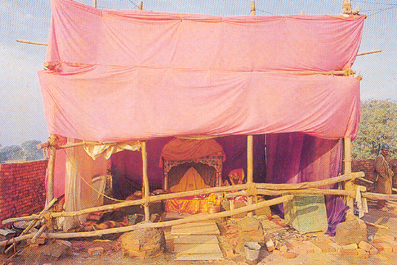 அது ராமர் கோயில்தான். அந்த இடம் ஸ்ரீராமருக்குத்தான் சொந்தம். அந்த இடமே தெய்வத் தன்மை உடையதாகவும் (ஹிந்தியில் “தேவ-துல்ய”) வழிபாட்டுக்குரியதாகவும் ஹிந்துக்களுக்கு இருந்திருக்கிறது. பாபர் அங்கு, அந்தச் சர்ச்சைக்குரிய கட்டிடத்தைக் கட்டுவதற்கு முன்னால் அங்கே ஒரு கோயில் அமைப்பு இருந்தது. அதை அவன் இடித்தானா இல்லையா என்பது கேள்விக்குரியது. ஆனால் அதன் இடிபாடுகளின் மீது- அவனுக்குச் சொந்தமில்லாத இடத்தில்- அவன் கட்டியதுதான் அந்தக் கட்டிடம். எனவே அது ”ராம் லல்லா” என்கிற குழந்தை ராமருக்குச் சொந்தமானது.
அது ராமர் கோயில்தான். அந்த இடம் ஸ்ரீராமருக்குத்தான் சொந்தம். அந்த இடமே தெய்வத் தன்மை உடையதாகவும் (ஹிந்தியில் “தேவ-துல்ய”) வழிபாட்டுக்குரியதாகவும் ஹிந்துக்களுக்கு இருந்திருக்கிறது. பாபர் அங்கு, அந்தச் சர்ச்சைக்குரிய கட்டிடத்தைக் கட்டுவதற்கு முன்னால் அங்கே ஒரு கோயில் அமைப்பு இருந்தது. அதை அவன் இடித்தானா இல்லையா என்பது கேள்விக்குரியது. ஆனால் அதன் இடிபாடுகளின் மீது- அவனுக்குச் சொந்தமில்லாத இடத்தில்- அவன் கட்டியதுதான் அந்தக் கட்டிடம். எனவே அது ”ராம் லல்லா” என்கிற குழந்தை ராமருக்குச் சொந்தமானது.
தீர்ப்பு தெளிவாகத்தான் இருந்தது. ஆங்கில, ஹிந்தி தொலைக்காட்சி சேனல்களில் அப்படியே சொல்லவும் செய்தார்கள். ஆனால் தமிழ்த் தொலைக்காட்சி சானல்களில் ராமர் என்கிற வார்த்தை வராமல் பார்த்துக் கொண்ட விதம், அந்தத் தீர்ப்பை முடிந்தவரை முஸ்லீம்களுக்குச் சாதகமாக வந்ததுபோல சொன்ன விதம் இருக்கிறதே, மகா சிறுபிள்ளைத்தனமாகவும், நகைப்புக்குரியதாகவும் இருந்தது!
மூன்று நீதிபதிகளுமே கும்மட்டம் இருந்த மையப்பகுதி, ஸ்ரீராம ஜென்ம பூமியின் இதயப்பகுதி ஹிந்துக்களுக்கு உரியது எனத் தெளிவாகவே சொல்லியிருக்கிறார்கள். அது மட்டுமல்ல, சர்ச்சைக்குரிய கட்டிடத்திற்கு முன்புறம் உள்ள ராம் சபூத்ரா மற்றும் சீதா கீ ரசோயீ ஆகிய வழிபாட்டு மேடைகள் உள்ள இடம் நிர்மோஹி அகாராவுக்கு அளிக்கப்பட வேண்டும் என்றும் கூறியுள்ளார்கள். நிர்மோஹி அகாரா என்ற மடம் 1885-லேயே ராமஜன்மபூமி விஷயமாக நீதிமன்றத்தை அணுகியவர்கள். அன்றைய பிரிட்டிஷ் அரசு ஹிந்துக்களுக்கு எதிராக நடந்தது. சுதந்திர பாரதத்தின் நீதித்துறை 60 வருடங்கள் கழித்தாவது அந்தக் களங்கத்தைத் துடைத்திருக்கிறது.
நீதிபதி கானின் தீர்ப்பில் இந்தச் சர்ச்சைக்குரிய பகுதி இப்படிப் பங்குபோடப்பட வேண்டுமெனக் கூறுகிறது:
மையக் கும்மட்டத்துக்குக் கீழே ராம்லாலா விக்கிரகங்கள் வைத்துள்ள தற்காலிகக் கோயில் அமைந்துள்ள பகுதி ஹிந்துக்களுக்கே இறுதியாக அளிக்கப்பட வேண்டும் என மேலும் அறிவுறுத்தப்படுகிறது. நிர்மோஹி அகாராவுக்கு ராம் சபுத்ரா பகுதியும் சீதா ரஸோயி பகுதியும் அளிக்கப்பட வேண்டும் என நெறியுறுத்தப்படுகிறது.
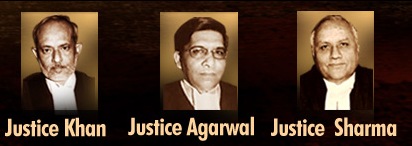
நீதிபதி சுகிர் அகர்வால் தனது தீர்ப்பில் கூறியிருப்பது:
மூன்று கும்மட்டங்கள் இருந்த இடத்திற்குக் கீழாக உள்ள பகுதி பகவான் ராம ஜென்மஸ்தான தெய்வம் என்றும் ஸ்ரீ ராமர் பிறந்த இடமாகவும் ஹிந்து மத நம்பிக்கை கருதுவதால் அது ஹிந்துக்களுக்கு உரியதாகும். வழக்குத் தொடுத்தவர்கள் (அதாவது முஸ்லீம்கள்) அதற்கு எந்த இடையூறும் எவ்விதத்திலும் செய்யக் கூடாது.
நீதிபதி தரம் வீர் ஷர்மா தனது தீர்ப்புச் சுருக்கத்தில் முன்னுள்ள கேள்விகளுக்கு பதிலளிக்கையில் கூறியிருப்பது:
1. சர்ச்சைக்குரிய இடம்தான் ராமர் பிறந்த இடமா?
சர்ச்சைக்குரிய இடம்தான் ராமர் பிறந்த இடம். அந்த இடமே சட்டரீதியில் ஓர் ஆளுமையாகவும் தெய்வமாகவும் கருதப்பட வேண்டும். ஏனெனில் அது பகவான் ராமர் குழந்தையாகப் பிறந்த இடமாக, இறைத்தன்மையை வெளிப்படுத்துகிறது.
2. சர்ச்சைக்குரிய கட்டிடம் மசூதியா? அது எப்போது கட்டப்பட்டது? யாரால் கட்டப்பட்டது?
சர்ச்சைக்குரிய கட்டிடம் பாபரால் கட்டப்பட்டது. அது கட்டப்பட்ட ஆண்டு சரியாகத் தெரியவில்லை. அது இஸ்லாமிய மதநெறிகளுக்கு மாறாகக் கட்டப்பட்டது. எனவே அது ஒரு மசூதியாகக் கருதப்பட முடியாது.
3. அங்கு மசூதி ஹிந்து கோவிலை இடித்த பிறகு கட்டப்பட்டதா?
அங்கு ஏற்கனவே இருந்த ஒரு பழமையான கட்டிடத்தை இடித்துவிட்டு அந்தச் சர்ச்சைக்குரிய கட்டிடம் கட்டப்பட்டது. இந்திய அகழ்வாராய்ச்சிக் கழகம் அந்த இடிக்கப்பட்ட கட்டிடம் ஒரு பிரம்மாண்டமான ஹிந்து மத வழிபாட்டுக் கட்டிடம் என்பதை ஆதாரபூர்வமாக நிறுவியுள்ளது.
ஆனால் இது ஒரு நிலத் தகராறுப் பிரச்சினையோ அல்லது மத வழிபாட்டுத்தலம் குறித்த இரு சாராரின் பிரச்சினையோ மட்டும் அல்ல. தேசம் குறித்த இரு அடிப்படையான பார்வைகள் இங்கே மோதியுள்ளன.
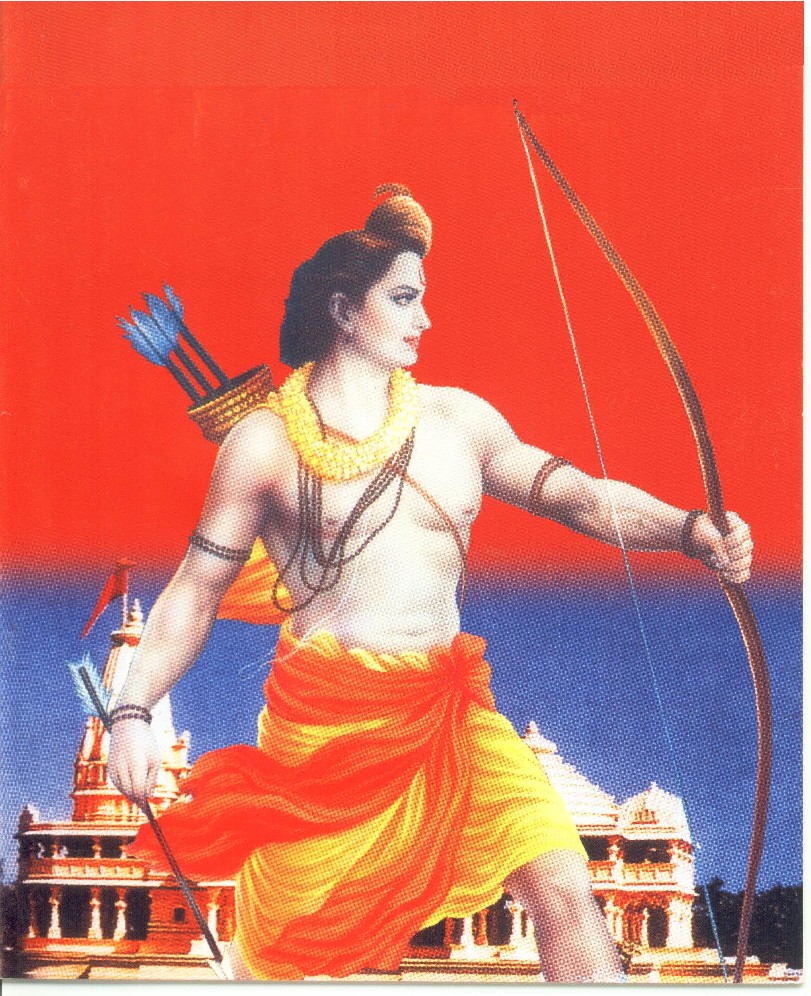 இந்தத் தேசத்துக்கென்று ஒரு பண்பாட்டு வளமை உள்ளது. அதுவே இந்தத் தேசத்தை ஒன்றுபடுத்துகிறது. அதன் அடிப்படையிலேயே நாம் நம் மக்களை ஒருங்கிணைக்க வேண்டும். குறுகிய சுயநல அரசியல் இலாபங்களுக்காக, அந்தப் பண்பாட்டு மதிப்பீடுகளை நாம் பலி கொடுத்துவிடக்கூடாது என்பது ஒரு பார்வை.
இந்தத் தேசத்துக்கென்று ஒரு பண்பாட்டு வளமை உள்ளது. அதுவே இந்தத் தேசத்தை ஒன்றுபடுத்துகிறது. அதன் அடிப்படையிலேயே நாம் நம் மக்களை ஒருங்கிணைக்க வேண்டும். குறுகிய சுயநல அரசியல் இலாபங்களுக்காக, அந்தப் பண்பாட்டு மதிப்பீடுகளை நாம் பலி கொடுத்துவிடக்கூடாது என்பது ஒரு பார்வை.
மாறாக நமக்கென்று ஒரு பண்பாடு கிடையாது. ஒரு சமுதாயத்தை தாஜா செய்து, ஒவ்வொரு சமுதாயத்தையும் ஒன்றோடொன்று மோதவிட்டு அரசியல் நடத்துவதே சாலச்சிறந்தது என்கிற மற்றொரு பார்வை. அந்நியர்களையும் அரசியல் இலாபமிருந்தால் தேசிய நாயகர்களாக்கும் வக்கிரம் கொண்ட அந்தப் பார்வை மதச்சார்பின்மை என்கிற பெயரில் இந்த நாட்டில் கோலோச்சியது. இந்தத் தேசத்தின் வரலாற்றை வெறுமனே அதிகாரத்தையும் பொருளாதார உறவுகளையும் மட்டுமே கொண்டு கட்டுடைக்கும் பார்வை அது.
அதே நேரத்தில், தேசிய அளவில் கருத்துரீதியாக வெற்றிடத்தை உருவாக்கி, அங்கு அந்நிய தேசக் கருத்தாங்கங்ளை விதைத்து, ஆன்ம அறுவடைக்கென களம் இறங்கியிருந்தன ஆக்கிரமிப்பு மத சக்திகள்.
வாக்கு வங்கிகளுக்காக மக்களைப் பிளக்கும் போலி மதச்சார்பின்மையும், வலுவற்ற வக்கிர அரசியலைப் பயன்படுத்தி விரிவாதிக்க ஆன்ம அறுவடை செய்யும் சக்திகளும் கைகோர்த்ததன் சின்னமாக மாறியது பாப்ரி கும்மட்டம். சோவியத் உடைந்த காலகட்டம் அது. வளமையான புரவலனை இழந்த இந்திய இடதுசாரி அறிவுஜீவிகளுக்கும் வகாபிய இஸ்லாமிய சக்திகள் கைகொடுக்க முன்வந்தன.
அதன் விளைவாக மவுண்ட்ரோடு மாவோ பத்திரிகை உள்ளிட்ட எல்லா இந்திய இடதுசாரி அறிவுஜீவிகளும் இஸ்லாமிய நேசர்களானார்கள். பொதுவாகவே மார்க்ஸியச் சித்தாந்திகளுக்கு வகாபிய இஸ்லாமியக் கருத்தியல் சாய்வு உண்டு. அமெரிக்கா போன்ற நாடுகளுக்கும் கூட, இஸ்லாமியச் சக்திகளை எங்கும் தாக்கும்போது தங்களை இஸ்லாமிய எதிர்ப்பாளர் அல்ல எனக் காட்ட இந்தியாவில் ஹிந்துத்துவத்தை தாக்குவது, ஓர் அருமையான பப்ளிக் ரிலேஷன் தந்திரம். (1990-களின் தொடக்கத்தில்தான் முதலாம் புஷ் ஈராக்கின் மீது தாக்குதலை ஆரம்பித்திருந்தார் என்பதையும் நினைவில் கொள்ளவேண்டும்.) எனவே அமெரிக்கப் பல்கலைக்கழகங்களின் இந்திய நோக்கர்கள் உட்பட இந்திய இடதுசாரிகளின் இஸ்லாமிய நேசபாவத்தை முழு மனதுடன் ஆதரித்தனர். உலக அரங்கில் ஹிந்துத்துவர்கள் சர்வதேச வில்லன்களாக்கப்பட்டனர்.
1992 டிசம்பர்-6 வலதுசாரி-இடதுசாரி வேறுபாடில்லாமல் கறுப்பு ஞாயிறாகச் சித்தரிக்கப்பட்டது. சோதுக்ளக்குக்கு கறுப்புச் சட்டை போட்டார். இல்லாத மசூதிக்குப் பொல்லாத ஆர்ப்பாட்டம் நடத்தப்பட்டது. இஸ்லாமியச் சகோதரர்களுக்கு ஏதோ பெரிய அநியாயம் செய்யப்பட்டு விட்டதாக ஒவ்வொரு டிசம்பர் 6-ஆம் தேதியும் அவர்களுக்குப் போதிக்கப்பட்டது. இந்த 18 வருட பொய்ப் பிரசாரத்தைத்தான் அக்குவேறு ஆணி வேறாக இந்தத் தீர்ப்பு உடைத்து எறிந்திருக்கிறது.
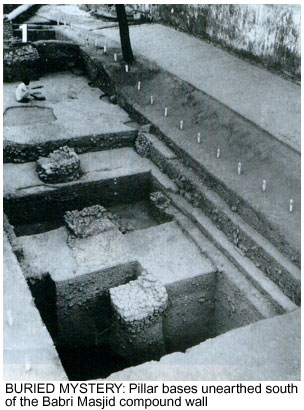 சரி, உண்மையைத் தீர விசாரிப்போம் என்று அரசே ஆணையிட்டு 2003-இல் அகழ்வாராய்ச்சி மேற்கொள்ளப்பட்ட போதுதான் எத்தனை எதிர்ப்புகள்! எத்தனை போலித்தனமான ஊடக விளையாட்டுகள்! ஒன்றை மட்டும் பார்க்கலாம். அவுட்லுக் பத்திரிகையின் எழுத்தாளர் சந்தீபன் தேப் அயோத்தி அகழ்வாராய்ச்சி நடக்கும் இடத்துக்குச் சென்று அங்கு நடக்கும் அகழ்வாராய்ச்சி கண்டுபிடித்த விஷயங்களைக் கட்டுரையாக எழுதினார். அங்கு பல சுதைச் சிற்பங்கள், பழைய தேவநாகரி லிபியில் எழுதப்பட்ட ஒரு கல்வெட்டு ஆகியவை கிடைத்திருப்பதை அவர் எழுதினார். இதற்கு இர்பான் ஹபீப் கடுமையான எதிர்ப்புத் தெரிவித்தார். இந்திய அகழ்வாராய்ச்சி நிறுவனத்தின் இடைக்கால அறிக்கைகளில் பாப்ரி அமைப்பின் கீழே எவ்வித பிறிதொரு அமைப்பும் இருந்ததற்கான ஆதாரமும் இல்லை எனச் சொல்லி வந்தார்கள். சந்தீபன் தேப் இந்தக் கேள்விகளுக்கெல்லாம் எழுதிய பதிலில் குறிப்பிட்டார்:
சரி, உண்மையைத் தீர விசாரிப்போம் என்று அரசே ஆணையிட்டு 2003-இல் அகழ்வாராய்ச்சி மேற்கொள்ளப்பட்ட போதுதான் எத்தனை எதிர்ப்புகள்! எத்தனை போலித்தனமான ஊடக விளையாட்டுகள்! ஒன்றை மட்டும் பார்க்கலாம். அவுட்லுக் பத்திரிகையின் எழுத்தாளர் சந்தீபன் தேப் அயோத்தி அகழ்வாராய்ச்சி நடக்கும் இடத்துக்குச் சென்று அங்கு நடக்கும் அகழ்வாராய்ச்சி கண்டுபிடித்த விஷயங்களைக் கட்டுரையாக எழுதினார். அங்கு பல சுதைச் சிற்பங்கள், பழைய தேவநாகரி லிபியில் எழுதப்பட்ட ஒரு கல்வெட்டு ஆகியவை கிடைத்திருப்பதை அவர் எழுதினார். இதற்கு இர்பான் ஹபீப் கடுமையான எதிர்ப்புத் தெரிவித்தார். இந்திய அகழ்வாராய்ச்சி நிறுவனத்தின் இடைக்கால அறிக்கைகளில் பாப்ரி அமைப்பின் கீழே எவ்வித பிறிதொரு அமைப்பும் இருந்ததற்கான ஆதாரமும் இல்லை எனச் சொல்லி வந்தார்கள். சந்தீபன் தேப் இந்தக் கேள்விகளுக்கெல்லாம் எழுதிய பதிலில் குறிப்பிட்டார்:
”இந்திய அகழ்வாராய்ச்சி நிறுவனம் சமர்ப்பித்த புதிய (அதாவது இடைக்கால) அறிக்கை குறித்து எழுதிய பெரும்பாலான நாளேடுகள் பாப்ரி மசூதியின் கீழ் எவ்வித அமைப்பும் இல்லை என்று எழுதினாலும், உண்மையில் அந்த அறிக்கை என்ன சொல்கிறதென்றால், 30 அகழ்வாராய்ச்சிக்கான குழிகள் தோண்டப்பட்டதில், மனிதர்கள் உருவாக்கிய அமைப்புகள் 8 குழிகளில் கிட்டியுள்ளன. 16 குழிகளில் எதுவும் கிடைக்கவில்லை, 5 குழிகளில் மேலே இருக்கும் அமைப்பால் முடிவு செய்ய முடியவில்லை. ஒரு குழி இன்னும் தோண்டவில்லை. கண்டுபிடித்த விஷயங்களாக ஆவணம் சொல்லியிருப்பவை: கிழக்கு மேற்காகவும் வடக்கு தெற்காகவும் அமைக்கப்ப்ட்ட செங்கல் சுவர்களுக்கான ஆதாரம், அலங்காரத்துடனான வண்ணத் தரைகள், பல தூண்களின் அடித்தளங்கள், நான்கு பக்கங்களிலும் யக்க்ஷர்கள் கொண்ட 1.64 அடி நீளமுள்ள கருங்கல் தூண்” (அவுட்லுக், ஜூன் 23, 2003)
ஆனால், இர்பான் ஹபீப்பும், மற்ற பிரபல நாளேடுகளும் கோயிலுக்கான எவ்வித ஆதாரமும் இல்லை எனச் சொல்லத் தயங்கவில்லை; கூசவில்லை. இந்த ஏமாற்று வேலை தீர்ப்பு வருவதற்கு சில நாள்கள் முன்னால் கூட நடத்தப் பட்டது. CNN-IBN டிவியில், “அயோத்தித் தீர்ப்பு, வரலாற்று ஆதாரத்தை அடிப்படையாகக் கொண்டிருக்கும்” (Ayodhya dispute hinges on historical evidence) என்கிற தலைப்பில் ஒரு செய்தித் துணுக்கு. அதில் அகழ்வாராய்ச்சி அறிக்கை குறித்து ஓர் ஆராய்ச்சியாளர் பேசுகிறார். பின்னர் அந்த அறிக்கை தவறு என்று இஸ்லாமியர் ஒருவரும் பின்னர் தமோதர் ஜா என்கிற மார்க்ஸியரும் (இவரை, சர்வதேசப் புகழ்மிக்க வரலாற்று அறிஞர் என நிகழ்ச்சியில் சொல்கிறார்கள்.) இந்திய அகழ்வாராய்ச்சிக் கழகம் கண்டுபிடித்தது மசூதியைத்தான் என்று சொல்கிறார்கள். பிறகு செய்தித் தொகுப்பாளர், “வரலாற்று அறிஞர்கள் ஒருபக்கம் இப்படிச் சொல்கிறார்கள்; ஹிந்து தரப்போ இதை மறுக்கிறது” என்கிறார்! ஏதோ ஹிந்துக்கள் வரலாற்று ஆசிரியர்களுக்கு எதிர் என்றும், இஸ்லாமியர்களே வரலாற்று ஆதாரப்படி நடப்பதாகவும் ஓர் ஊடகப் பிரமையை வலிந்து உருவாக்குகிறார்கள்!
இத்தகைய ஊடக மோசடிகளையும் அயோத்தி தீர்ப்பு தகர்த்து எறிந்திருக்கிறது. இந்தத் தீர்ப்பு போலி அறிவுஜீவிகளும் விலைக்குப் போன ஊடகங்களும் உருவாக்கிப் பரப்பிய பொய்களை அம்பலப்படுத்தி, ஹிந்துக்கள் ஈடுபட்டது நியாயமான ஒரு போராட்டத்தில்தான் என்பதையும் தெளிவுப்படுத்தியிருக்கிறது. அந்த வகையிலும் இத்தீர்ப்பு முக்கியமானதாகிறது.
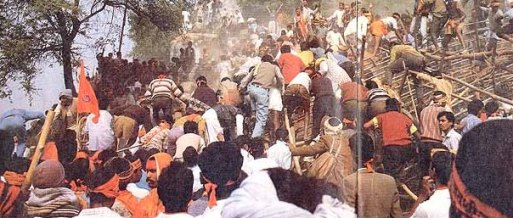
அயோத்தியில் அடிமைச் சின்னமான பாப்ரி கும்மட்டத்தை நீக்கும் அறப்போரில் கரசேவகர்கள் மௌலானா முலாயம் சிங்கின் குண்டடிகளைத் தங்கள் நெஞ்சில் சுமந்து பலிதானிகள் ஆனார்கள். ஆனால் அந்தத் தியாகிகளுக்கு மதவெறியர்கள் என்றும் மசூதியை இடித்தவர்கள் என்றும் பழி சுமத்தப்பட்டது. இன்று, அவர்கள் மதவெறியர்கள் அல்ல; தாய்நாட்டின் அவமானத்தைத் துடைத்த தேசபக்தர்கள் என்பது இந்தத் தீர்ப்பின் மூலம் நிலைநாட்டப் பட்டுள்ளது.
இந்தத் தீர்ப்பு அவர்கள் தியாகத்தினால் நமக்குக் கிடைத்திருக்கும் பிரசாதம். அதனால் நாம் மேலும் உத்வேகம் பெறுவோம். அனைத்து இந்திய மக்களையும்- குறிப்பாக இஸ்லாமியச் சகோதரர்களையும்- உண்மையை உணரச் செய்து, அயோத்தியில் ஸ்ரீ ராமனுக்கு மகோன்னதமானதோர் ஆலயத்தை, அன்பினால், சமரசத் தன்மையால் அமைப்போம்.
”இந்தத் தீர்ப்பு இப்ப வரலைன்னு யாரு அழுதா? இந்த இளைய தலைமுறைக்கு ராமர்னாலே யாருன்னு தெரியாது. அதைப் பத்தியெல்லாம் யாரும் கவலைப்படலை.” — இப்படியும் கமெண்ட்கள்.
இந்திய ஜனநாயகத்தின் மாபெரும் கறையான முடிசூடா இளவரசன் ராகுல் வின்சி என்கிற ராகுல் காந்தி,“அயோத்தியை விட முக்கிய விஷயங்கள் இருக்கின்றன” என்று சொல்ல பத்திரிகைகள் அதை அப்படியே பக்கங்களில் பிரதானமாக வாந்தியெடுத்தன. (கல்மாடி சுருட்டினதில் வாங்க வேண்டிய கப்பமா? குடும்ப நண்பர் குவிட்ரோச்சி கொடுக்க வேண்டிய கமிஷனா? – எது அயோத்தியை விட முக்கியம் என யாரும் கேட்கவில்லை.)
ஆனால் தீர்ப்பின் நேரம் நெருங்க நெருங்க நாடெங்கும் மக்கள் மூச்சைப் பிடித்துக் கொண்டு கவனித்தார்கள். மூன்றரை மணி– நான்கு– நான்கு இருபது- தீர்ப்பு வர ஆரம்பித்தது. சந்தித்த அனைவர் முகத்திலும் மகிழ்ச்சி தாண்டவமாடியது. போன்கால்கள் எஸ்.எம்.எஸ்கள் எதிர்பாராதவர்களிடமிருந்தெல்லாம் வர ஆரம்பித்தன!
தீர்ப்பு தெளிவாக இருந்தது.
 அது ராமர் கோயில்தான். அந்த இடம் ஸ்ரீராமருக்குத்தான் சொந்தம். அந்த இடமே தெய்வத் தன்மை உடையதாகவும் (ஹிந்தியில் “தேவ-துல்ய”) வழிபாட்டுக்குரியதாகவும் ஹிந்துக்களுக்கு இருந்திருக்கிறது. பாபர் அங்கு, அந்தச் சர்ச்சைக்குரிய கட்டிடத்தைக் கட்டுவதற்கு முன்னால் அங்கே ஒரு கோயில் அமைப்பு இருந்தது. அதை அவன் இடித்தானா இல்லையா என்பது கேள்விக்குரியது. ஆனால் அதன் இடிபாடுகளின் மீது- அவனுக்குச் சொந்தமில்லாத இடத்தில்- அவன் கட்டியதுதான் அந்தக் கட்டிடம். எனவே அது ”ராம் லல்லா” என்கிற குழந்தை ராமருக்குச் சொந்தமானது.
அது ராமர் கோயில்தான். அந்த இடம் ஸ்ரீராமருக்குத்தான் சொந்தம். அந்த இடமே தெய்வத் தன்மை உடையதாகவும் (ஹிந்தியில் “தேவ-துல்ய”) வழிபாட்டுக்குரியதாகவும் ஹிந்துக்களுக்கு இருந்திருக்கிறது. பாபர் அங்கு, அந்தச் சர்ச்சைக்குரிய கட்டிடத்தைக் கட்டுவதற்கு முன்னால் அங்கே ஒரு கோயில் அமைப்பு இருந்தது. அதை அவன் இடித்தானா இல்லையா என்பது கேள்விக்குரியது. ஆனால் அதன் இடிபாடுகளின் மீது- அவனுக்குச் சொந்தமில்லாத இடத்தில்- அவன் கட்டியதுதான் அந்தக் கட்டிடம். எனவே அது ”ராம் லல்லா” என்கிற குழந்தை ராமருக்குச் சொந்தமானது.தீர்ப்பு தெளிவாகத்தான் இருந்தது. ஆங்கில, ஹிந்தி தொலைக்காட்சி சேனல்களில் அப்படியே சொல்லவும் செய்தார்கள். ஆனால் தமிழ்த் தொலைக்காட்சி சானல்களில் ராமர் என்கிற வார்த்தை வராமல் பார்த்துக் கொண்ட விதம், அந்தத் தீர்ப்பை முடிந்தவரை முஸ்லீம்களுக்குச் சாதகமாக வந்ததுபோல சொன்ன விதம் இருக்கிறதே, மகா சிறுபிள்ளைத்தனமாகவும், நகைப்புக்குரியதாகவும் இருந்தது!
மூன்று நீதிபதிகளுமே கும்மட்டம் இருந்த மையப்பகுதி, ஸ்ரீராம ஜென்ம பூமியின் இதயப்பகுதி ஹிந்துக்களுக்கு உரியது எனத் தெளிவாகவே சொல்லியிருக்கிறார்கள். அது மட்டுமல்ல, சர்ச்சைக்குரிய கட்டிடத்திற்கு முன்புறம் உள்ள ராம் சபூத்ரா மற்றும் சீதா கீ ரசோயீ ஆகிய வழிபாட்டு மேடைகள் உள்ள இடம் நிர்மோஹி அகாராவுக்கு அளிக்கப்பட வேண்டும் என்றும் கூறியுள்ளார்கள். நிர்மோஹி அகாரா என்ற மடம் 1885-லேயே ராமஜன்மபூமி விஷயமாக நீதிமன்றத்தை அணுகியவர்கள். அன்றைய பிரிட்டிஷ் அரசு ஹிந்துக்களுக்கு எதிராக நடந்தது. சுதந்திர பாரதத்தின் நீதித்துறை 60 வருடங்கள் கழித்தாவது அந்தக் களங்கத்தைத் துடைத்திருக்கிறது.
நீதிபதி கானின் தீர்ப்பில் இந்தச் சர்ச்சைக்குரிய பகுதி இப்படிப் பங்குபோடப்பட வேண்டுமெனக் கூறுகிறது:
மையக் கும்மட்டத்துக்குக் கீழே ராம்லாலா விக்கிரகங்கள் வைத்துள்ள தற்காலிகக் கோயில் அமைந்துள்ள பகுதி ஹிந்துக்களுக்கே இறுதியாக அளிக்கப்பட வேண்டும் என மேலும் அறிவுறுத்தப்படுகிறது. நிர்மோஹி அகாராவுக்கு ராம் சபுத்ரா பகுதியும் சீதா ரஸோயி பகுதியும் அளிக்கப்பட வேண்டும் என நெறியுறுத்தப்படுகிறது.

நீதிபதி சுகிர் அகர்வால் தனது தீர்ப்பில் கூறியிருப்பது:
மூன்று கும்மட்டங்கள் இருந்த இடத்திற்குக் கீழாக உள்ள பகுதி பகவான் ராம ஜென்மஸ்தான தெய்வம் என்றும் ஸ்ரீ ராமர் பிறந்த இடமாகவும் ஹிந்து மத நம்பிக்கை கருதுவதால் அது ஹிந்துக்களுக்கு உரியதாகும். வழக்குத் தொடுத்தவர்கள் (அதாவது முஸ்லீம்கள்) அதற்கு எந்த இடையூறும் எவ்விதத்திலும் செய்யக் கூடாது.
நீதிபதி தரம் வீர் ஷர்மா தனது தீர்ப்புச் சுருக்கத்தில் முன்னுள்ள கேள்விகளுக்கு பதிலளிக்கையில் கூறியிருப்பது:
1. சர்ச்சைக்குரிய இடம்தான் ராமர் பிறந்த இடமா?
சர்ச்சைக்குரிய இடம்தான் ராமர் பிறந்த இடம். அந்த இடமே சட்டரீதியில் ஓர் ஆளுமையாகவும் தெய்வமாகவும் கருதப்பட வேண்டும். ஏனெனில் அது பகவான் ராமர் குழந்தையாகப் பிறந்த இடமாக, இறைத்தன்மையை வெளிப்படுத்துகிறது.
2. சர்ச்சைக்குரிய கட்டிடம் மசூதியா? அது எப்போது கட்டப்பட்டது? யாரால் கட்டப்பட்டது?
சர்ச்சைக்குரிய கட்டிடம் பாபரால் கட்டப்பட்டது. அது கட்டப்பட்ட ஆண்டு சரியாகத் தெரியவில்லை. அது இஸ்லாமிய மதநெறிகளுக்கு மாறாகக் கட்டப்பட்டது. எனவே அது ஒரு மசூதியாகக் கருதப்பட முடியாது.
3. அங்கு மசூதி ஹிந்து கோவிலை இடித்த பிறகு கட்டப்பட்டதா?
அங்கு ஏற்கனவே இருந்த ஒரு பழமையான கட்டிடத்தை இடித்துவிட்டு அந்தச் சர்ச்சைக்குரிய கட்டிடம் கட்டப்பட்டது. இந்திய அகழ்வாராய்ச்சிக் கழகம் அந்த இடிக்கப்பட்ட கட்டிடம் ஒரு பிரம்மாண்டமான ஹிந்து மத வழிபாட்டுக் கட்டிடம் என்பதை ஆதாரபூர்வமாக நிறுவியுள்ளது.
************
இதே விஷயங்களைத்தான் ஹிந்துத்துவ வாதிகளும், அயோத்தி இயக்கத்தை முன்னெடுத்து நடத்தியவர்களும் இத்தனை ஆண்டுகளாகக் கூறிவந்துள்ளார்கள். ஆனால் ஊடகங்களும், இடதுசாரி அறிவுஜீவிகளும் ஏதோ பிரம்மாண்டமான- தினசரி தொழுகை நடத்தி வரப்பட்ட- மசூதியை ஹிந்துத்துவர்கள் இடித்துவிட்டதாகப் பொய்ப் பிரசாரம் செய்தார்கள். அதன் விளைவாகவே இந்தியா முழுக்க கலவரங்கள் உருவாகின. மதச்சார்பின்மையின் நாயகன்களாகவும் சிறுபான்மையினரின் காவலன்களாகவும் தங்களைக் காட்டிக்கொள்ள இந்த அறிவுஜீவிகள் அப்பாவிகளின் இரத்த ஆற்றில் மூழ்கி முக்குளிக்கவும் தயங்கவில்லை.ஆனால் இது ஒரு நிலத் தகராறுப் பிரச்சினையோ அல்லது மத வழிபாட்டுத்தலம் குறித்த இரு சாராரின் பிரச்சினையோ மட்டும் அல்ல. தேசம் குறித்த இரு அடிப்படையான பார்வைகள் இங்கே மோதியுள்ளன.
 இந்தத் தேசத்துக்கென்று ஒரு பண்பாட்டு வளமை உள்ளது. அதுவே இந்தத் தேசத்தை ஒன்றுபடுத்துகிறது. அதன் அடிப்படையிலேயே நாம் நம் மக்களை ஒருங்கிணைக்க வேண்டும். குறுகிய சுயநல அரசியல் இலாபங்களுக்காக, அந்தப் பண்பாட்டு மதிப்பீடுகளை நாம் பலி கொடுத்துவிடக்கூடாது என்பது ஒரு பார்வை.
இந்தத் தேசத்துக்கென்று ஒரு பண்பாட்டு வளமை உள்ளது. அதுவே இந்தத் தேசத்தை ஒன்றுபடுத்துகிறது. அதன் அடிப்படையிலேயே நாம் நம் மக்களை ஒருங்கிணைக்க வேண்டும். குறுகிய சுயநல அரசியல் இலாபங்களுக்காக, அந்தப் பண்பாட்டு மதிப்பீடுகளை நாம் பலி கொடுத்துவிடக்கூடாது என்பது ஒரு பார்வை.மாறாக நமக்கென்று ஒரு பண்பாடு கிடையாது. ஒரு சமுதாயத்தை தாஜா செய்து, ஒவ்வொரு சமுதாயத்தையும் ஒன்றோடொன்று மோதவிட்டு அரசியல் நடத்துவதே சாலச்சிறந்தது என்கிற மற்றொரு பார்வை. அந்நியர்களையும் அரசியல் இலாபமிருந்தால் தேசிய நாயகர்களாக்கும் வக்கிரம் கொண்ட அந்தப் பார்வை மதச்சார்பின்மை என்கிற பெயரில் இந்த நாட்டில் கோலோச்சியது. இந்தத் தேசத்தின் வரலாற்றை வெறுமனே அதிகாரத்தையும் பொருளாதார உறவுகளையும் மட்டுமே கொண்டு கட்டுடைக்கும் பார்வை அது.
அதே நேரத்தில், தேசிய அளவில் கருத்துரீதியாக வெற்றிடத்தை உருவாக்கி, அங்கு அந்நிய தேசக் கருத்தாங்கங்ளை விதைத்து, ஆன்ம அறுவடைக்கென களம் இறங்கியிருந்தன ஆக்கிரமிப்பு மத சக்திகள்.
வாக்கு வங்கிகளுக்காக மக்களைப் பிளக்கும் போலி மதச்சார்பின்மையும், வலுவற்ற வக்கிர அரசியலைப் பயன்படுத்தி விரிவாதிக்க ஆன்ம அறுவடை செய்யும் சக்திகளும் கைகோர்த்ததன் சின்னமாக மாறியது பாப்ரி கும்மட்டம். சோவியத் உடைந்த காலகட்டம் அது. வளமையான புரவலனை இழந்த இந்திய இடதுசாரி அறிவுஜீவிகளுக்கும் வகாபிய இஸ்லாமிய சக்திகள் கைகொடுக்க முன்வந்தன.
அதன் விளைவாக மவுண்ட்ரோடு மாவோ பத்திரிகை உள்ளிட்ட எல்லா இந்திய இடதுசாரி அறிவுஜீவிகளும் இஸ்லாமிய நேசர்களானார்கள். பொதுவாகவே மார்க்ஸியச் சித்தாந்திகளுக்கு வகாபிய இஸ்லாமியக் கருத்தியல் சாய்வு உண்டு. அமெரிக்கா போன்ற நாடுகளுக்கும் கூட, இஸ்லாமியச் சக்திகளை எங்கும் தாக்கும்போது தங்களை இஸ்லாமிய எதிர்ப்பாளர் அல்ல எனக் காட்ட இந்தியாவில் ஹிந்துத்துவத்தை தாக்குவது, ஓர் அருமையான பப்ளிக் ரிலேஷன் தந்திரம். (1990-களின் தொடக்கத்தில்தான் முதலாம் புஷ் ஈராக்கின் மீது தாக்குதலை ஆரம்பித்திருந்தார் என்பதையும் நினைவில் கொள்ளவேண்டும்.) எனவே அமெரிக்கப் பல்கலைக்கழகங்களின் இந்திய நோக்கர்கள் உட்பட இந்திய இடதுசாரிகளின் இஸ்லாமிய நேசபாவத்தை முழு மனதுடன் ஆதரித்தனர். உலக அரங்கில் ஹிந்துத்துவர்கள் சர்வதேச வில்லன்களாக்கப்பட்டனர்.
1992 டிசம்பர்-6 வலதுசாரி-இடதுசாரி வேறுபாடில்லாமல் கறுப்பு ஞாயிறாகச் சித்தரிக்கப்பட்டது. சோதுக்ளக்குக்கு கறுப்புச் சட்டை போட்டார். இல்லாத மசூதிக்குப் பொல்லாத ஆர்ப்பாட்டம் நடத்தப்பட்டது. இஸ்லாமியச் சகோதரர்களுக்கு ஏதோ பெரிய அநியாயம் செய்யப்பட்டு விட்டதாக ஒவ்வொரு டிசம்பர் 6-ஆம் தேதியும் அவர்களுக்குப் போதிக்கப்பட்டது. இந்த 18 வருட பொய்ப் பிரசாரத்தைத்தான் அக்குவேறு ஆணி வேறாக இந்தத் தீர்ப்பு உடைத்து எறிந்திருக்கிறது.
************
 சரி, உண்மையைத் தீர விசாரிப்போம் என்று அரசே ஆணையிட்டு 2003-இல் அகழ்வாராய்ச்சி மேற்கொள்ளப்பட்ட போதுதான் எத்தனை எதிர்ப்புகள்! எத்தனை போலித்தனமான ஊடக விளையாட்டுகள்! ஒன்றை மட்டும் பார்க்கலாம். அவுட்லுக் பத்திரிகையின் எழுத்தாளர் சந்தீபன் தேப் அயோத்தி அகழ்வாராய்ச்சி நடக்கும் இடத்துக்குச் சென்று அங்கு நடக்கும் அகழ்வாராய்ச்சி கண்டுபிடித்த விஷயங்களைக் கட்டுரையாக எழுதினார். அங்கு பல சுதைச் சிற்பங்கள், பழைய தேவநாகரி லிபியில் எழுதப்பட்ட ஒரு கல்வெட்டு ஆகியவை கிடைத்திருப்பதை அவர் எழுதினார். இதற்கு இர்பான் ஹபீப் கடுமையான எதிர்ப்புத் தெரிவித்தார். இந்திய அகழ்வாராய்ச்சி நிறுவனத்தின் இடைக்கால அறிக்கைகளில் பாப்ரி அமைப்பின் கீழே எவ்வித பிறிதொரு அமைப்பும் இருந்ததற்கான ஆதாரமும் இல்லை எனச் சொல்லி வந்தார்கள். சந்தீபன் தேப் இந்தக் கேள்விகளுக்கெல்லாம் எழுதிய பதிலில் குறிப்பிட்டார்:
சரி, உண்மையைத் தீர விசாரிப்போம் என்று அரசே ஆணையிட்டு 2003-இல் அகழ்வாராய்ச்சி மேற்கொள்ளப்பட்ட போதுதான் எத்தனை எதிர்ப்புகள்! எத்தனை போலித்தனமான ஊடக விளையாட்டுகள்! ஒன்றை மட்டும் பார்க்கலாம். அவுட்லுக் பத்திரிகையின் எழுத்தாளர் சந்தீபன் தேப் அயோத்தி அகழ்வாராய்ச்சி நடக்கும் இடத்துக்குச் சென்று அங்கு நடக்கும் அகழ்வாராய்ச்சி கண்டுபிடித்த விஷயங்களைக் கட்டுரையாக எழுதினார். அங்கு பல சுதைச் சிற்பங்கள், பழைய தேவநாகரி லிபியில் எழுதப்பட்ட ஒரு கல்வெட்டு ஆகியவை கிடைத்திருப்பதை அவர் எழுதினார். இதற்கு இர்பான் ஹபீப் கடுமையான எதிர்ப்புத் தெரிவித்தார். இந்திய அகழ்வாராய்ச்சி நிறுவனத்தின் இடைக்கால அறிக்கைகளில் பாப்ரி அமைப்பின் கீழே எவ்வித பிறிதொரு அமைப்பும் இருந்ததற்கான ஆதாரமும் இல்லை எனச் சொல்லி வந்தார்கள். சந்தீபன் தேப் இந்தக் கேள்விகளுக்கெல்லாம் எழுதிய பதிலில் குறிப்பிட்டார்:”இந்திய அகழ்வாராய்ச்சி நிறுவனம் சமர்ப்பித்த புதிய (அதாவது இடைக்கால) அறிக்கை குறித்து எழுதிய பெரும்பாலான நாளேடுகள் பாப்ரி மசூதியின் கீழ் எவ்வித அமைப்பும் இல்லை என்று எழுதினாலும், உண்மையில் அந்த அறிக்கை என்ன சொல்கிறதென்றால், 30 அகழ்வாராய்ச்சிக்கான குழிகள் தோண்டப்பட்டதில், மனிதர்கள் உருவாக்கிய அமைப்புகள் 8 குழிகளில் கிட்டியுள்ளன. 16 குழிகளில் எதுவும் கிடைக்கவில்லை, 5 குழிகளில் மேலே இருக்கும் அமைப்பால் முடிவு செய்ய முடியவில்லை. ஒரு குழி இன்னும் தோண்டவில்லை. கண்டுபிடித்த விஷயங்களாக ஆவணம் சொல்லியிருப்பவை: கிழக்கு மேற்காகவும் வடக்கு தெற்காகவும் அமைக்கப்ப்ட்ட செங்கல் சுவர்களுக்கான ஆதாரம், அலங்காரத்துடனான வண்ணத் தரைகள், பல தூண்களின் அடித்தளங்கள், நான்கு பக்கங்களிலும் யக்க்ஷர்கள் கொண்ட 1.64 அடி நீளமுள்ள கருங்கல் தூண்” (அவுட்லுக், ஜூன் 23, 2003)
ஆனால், இர்பான் ஹபீப்பும், மற்ற பிரபல நாளேடுகளும் கோயிலுக்கான எவ்வித ஆதாரமும் இல்லை எனச் சொல்லத் தயங்கவில்லை; கூசவில்லை. இந்த ஏமாற்று வேலை தீர்ப்பு வருவதற்கு சில நாள்கள் முன்னால் கூட நடத்தப் பட்டது. CNN-IBN டிவியில், “அயோத்தித் தீர்ப்பு, வரலாற்று ஆதாரத்தை அடிப்படையாகக் கொண்டிருக்கும்” (Ayodhya dispute hinges on historical evidence) என்கிற தலைப்பில் ஒரு செய்தித் துணுக்கு. அதில் அகழ்வாராய்ச்சி அறிக்கை குறித்து ஓர் ஆராய்ச்சியாளர் பேசுகிறார். பின்னர் அந்த அறிக்கை தவறு என்று இஸ்லாமியர் ஒருவரும் பின்னர் தமோதர் ஜா என்கிற மார்க்ஸியரும் (இவரை, சர்வதேசப் புகழ்மிக்க வரலாற்று அறிஞர் என நிகழ்ச்சியில் சொல்கிறார்கள்.) இந்திய அகழ்வாராய்ச்சிக் கழகம் கண்டுபிடித்தது மசூதியைத்தான் என்று சொல்கிறார்கள். பிறகு செய்தித் தொகுப்பாளர், “வரலாற்று அறிஞர்கள் ஒருபக்கம் இப்படிச் சொல்கிறார்கள்; ஹிந்து தரப்போ இதை மறுக்கிறது” என்கிறார்! ஏதோ ஹிந்துக்கள் வரலாற்று ஆசிரியர்களுக்கு எதிர் என்றும், இஸ்லாமியர்களே வரலாற்று ஆதாரப்படி நடப்பதாகவும் ஓர் ஊடகப் பிரமையை வலிந்து உருவாக்குகிறார்கள்!
இத்தகைய ஊடக மோசடிகளையும் அயோத்தி தீர்ப்பு தகர்த்து எறிந்திருக்கிறது. இந்தத் தீர்ப்பு போலி அறிவுஜீவிகளும் விலைக்குப் போன ஊடகங்களும் உருவாக்கிப் பரப்பிய பொய்களை அம்பலப்படுத்தி, ஹிந்துக்கள் ஈடுபட்டது நியாயமான ஒரு போராட்டத்தில்தான் என்பதையும் தெளிவுப்படுத்தியிருக்கிறது. அந்த வகையிலும் இத்தீர்ப்பு முக்கியமானதாகிறது.

அயோத்தியில் அடிமைச் சின்னமான பாப்ரி கும்மட்டத்தை நீக்கும் அறப்போரில் கரசேவகர்கள் மௌலானா முலாயம் சிங்கின் குண்டடிகளைத் தங்கள் நெஞ்சில் சுமந்து பலிதானிகள் ஆனார்கள். ஆனால் அந்தத் தியாகிகளுக்கு மதவெறியர்கள் என்றும் மசூதியை இடித்தவர்கள் என்றும் பழி சுமத்தப்பட்டது. இன்று, அவர்கள் மதவெறியர்கள் அல்ல; தாய்நாட்டின் அவமானத்தைத் துடைத்த தேசபக்தர்கள் என்பது இந்தத் தீர்ப்பின் மூலம் நிலைநாட்டப் பட்டுள்ளது.
இந்தத் தீர்ப்பு அவர்கள் தியாகத்தினால் நமக்குக் கிடைத்திருக்கும் பிரசாதம். அதனால் நாம் மேலும் உத்வேகம் பெறுவோம். அனைத்து இந்திய மக்களையும்- குறிப்பாக இஸ்லாமியச் சகோதரர்களையும்- உண்மையை உணரச் செய்து, அயோத்தியில் ஸ்ரீ ராமனுக்கு மகோன்னதமானதோர் ஆலயத்தை, அன்பினால், சமரசத் தன்மையால் அமைப்போம்.
No comments:
Post a Comment